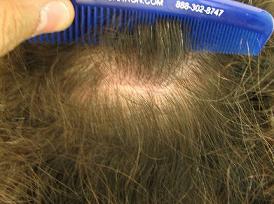Addressing the Challenge of Scalp Scars
 Parsa Mohebi, MD
Parsa Mohebi, MD
Since the advent of hair transplant surgery, hair transplant surgeons have been challenged to address the scarring that is inevitable from the donor wound in strip hair transplants. Other types of scalp surgeries such as neurological surgeries can also leave linear type scars in the scalp.
In addition trauma to the head can leave a person with unwanted scar. A patient’s natural hair coverage can obscure the visibility of a scar in most cases. However, proximity to a patient’s hairline and or wearing the hair too short can make a scar more obvious.
A hair transplant surgeon can easily repair or camouflage most scalp scars. The variations in a scar shape, location and size are key factors affecting the techniques that a surgeon will use in the revisioning of the scar. The singular and most important purpose of the scar revisioning is to obscure or minimize its appearance to the naked eye. Scar revisioning is not merely cosmetic. Disfigurement from scarring often affects a person’s sense of well being and self worth. Do to the inherent nature of the work they do cosmetic surgeons are at the forefront of minimizing the appearance of scars. We have developed an algorithm utilized in hair restoration and other surgical cosmetic practices that effectively meets the challenge of scarring from these procedures. Many of the same techniques are also employed in addressing scalp scarring from trauma and scalp surgical procedures.
Medical excellence is predicated on examination. Physically examining the scar is essential in determining what proportion of scar visibility is due to stretching, hypertrophic reaction and or hair transaction.
A scar that is wider than expected gives evidence that some level of stretching has occurred. Skin that is stretched typically has a contrasting color to neighboring skin. Minimizing this contrast is one of the key approaches to reducing this type of scar. Hair transplant surgeon can reduce the contrast by bringing hair inside the scar by a variety of techniques to minimize the contrast between the hair bearing scalp and non-hair bearing scar. That is done through placing follicular unit grafts with FUE procedure or by performing trichophytic closure on one or both edges of a scalp scar. Many people may need more than one hair transplant into their scalp to improve the reduction in visibility of the scar.
Every cosmetic surgeon should be familiar and knowledgeable about the cosmetic products or non-medical methods that could be used to improve scars. When managing a scalp scar, we always consider and discuss with the patients the role of a variety of techniques that might be used solely or in conjunction with surgical procedures for further improving appearance of scars. Some of these are; microfibers, foundations, and coloring agents for skin and hair or tattooing of scalp.
If you are suffering from a scalp scar, you need to find a good hair transplant surgeon with plenty of experience with treatment of scalp scars. A simple consultation would make the overall plan clear. The plan may include a surgical procedure, using cosmetics for hair and scalp and hair style changes.


